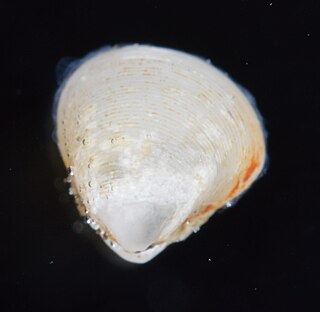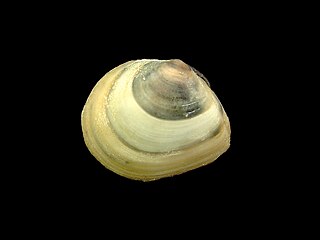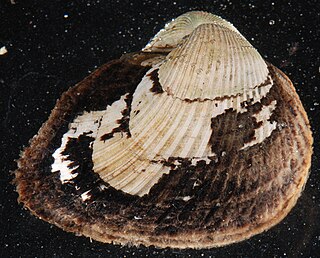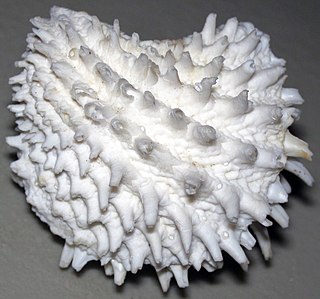
Clam is a common name for several kinds of bivalve molluscs. The word is often applied only to those that are edible and live as infauna, spending most of their lives halfway buried in the sand of the seafloor or riverbeds. Clams have two shells of equal size connected by two adductor muscles and have a powerful burrowing foot. They live in both freshwater and marine environments; in salt water they prefer to burrow down into the mud and the turbidity of the water required varies with species and location; the greatest diversity of these is in North America.

The knobbed whelk is a species of very large predatory sea snail, or in the US, a whelk, a marine gastropod mollusk in the family Busyconidae, the busycon whelks.

The amethyst gem clam is species of very small saltwater clam, a marine bivalve mollusk in the family Veneridae, the Venus clams.

Nuculidae is a family of small saltwater clams in the order Nuculida. Species in this family are commonly known as nut clams.

The Atlantic surf clam, also called the bar clam, hen clam, skimmer or simply sea clam, is a very large, edible, saltwater clam or marine bivalve mollusk in the family Mactridae. It is commonly found in the western Atlantic Ocean. Reaching up to 20 centimetres (7.9 in) or more in length, it is much larger than Spisula solida, which resides in the eastern Atlantic waters off of Great Britain.

Limecola balthica, commonly called the Baltic macoma, Baltic clam or Baltic tellin, is a small saltwater clam, a marine bivalve mollusk in the family Tellinidae.

Venerupis philippinarum is an edible species of saltwater clam in the family Veneridae, the Venus clams.

Donax variabilis, known by the common name coquina, is a species of small edible saltwater clam, a marine bivalve mollusc in the family Donacidae, the bean clams. It is a warm water species which occurs in shallow water on sandy beaches on the east coast of the United States.
Nucula atacellana, or the cancellate nut shell clam, is a marine bivalve mollusc in the family Nuculidae. It can be found along the Atlantic coast of North America, ranging from Cape Cod to Virginia.

Nucula delphinodonta, or the dolphin-tooth nut shell clam, is a marine bivalve mollusc in the family Nuculidae. It can be found along the Atlantic coast of North America, ranging from Labrador to Maryland.
Nucula tenuis, or the smooth nut clam, is a marine bivalve mollusc in the family Nuculidae. It can be found along the Atlantic coast of North America, ranging from Labrador to Maryland.

Noetia ponderosa, or the ponderous ark clam, is a marine clam in the family Noetiidae. It can be found along the Atlantic coast of North America, ranging from Virginia to Florida, West Indies, Gulf of Mexico, and Caribbean Central America.

Anomia simplex, the common jingle shell, is a typical species of bivalve mollusc in the family of Anomiidae, sharing attributes to blue mussels, American oysters, and bay scallops. Species related to the family of Anomiidae are often noted for their extremely thin, often translucent, paper-like shells. Anomia simplex can be found in shallow waters, typically estuaries, mainly along the Atlantic Coast of North America; however, they can range from as far north as the coast of Nova Scotia, and as far south as the coast of Brazil.

Arcinella arcinella, or the Caribbean spiny jewel box clam, is a species of bivalve mollusc in the family Chamidae.

Arcinella cornuta, or the Florida spiny jewelbox clam , is a marine species of bivalve mollusc in the family Chamidae. It can be found along the coast of North Carolina to Florida, Gulf of Mexico, Caribbean Central America, and Venezuela.

Mulinia lateralis, the dwarf surf clam or coot clam, is a species of small saltwater clam, a bivalve mollusc in the family Mactridae. It occurs in the western Atlantic Ocean and the Caribbean Sea.

Acanthocardia aculeata, the spiny cockle, is a species of saltwater clams, marine bivalve molluscs in the family Cardiidae. The genus Acanthocardia is present from the Upper Oligocene to the Recent.

Donax fossor is a species of small saltwater clam, a marine bivalve mollusc species in the family Donacidae. This species is native to the eastern coast of the US, as far north as New York State; in the past it was sometimes incorrectly considered to be a northern, less colorful form of Donax variabilis.

Cardites floridana, or the Broad-ribbed Carditid, is a marine clam in the family Carditidae. It can be found along the coasts of Florida, Central America, South America and the Gulf of Mexico.

Ennucula aegeensis, commonly known as the Aegean nut clam, is a nut clam present in the Atlantic Ocean, Gulf of Mexico, and the Mediterranean.


















